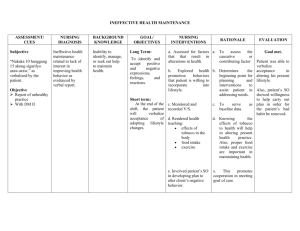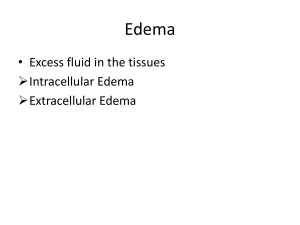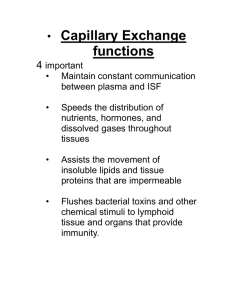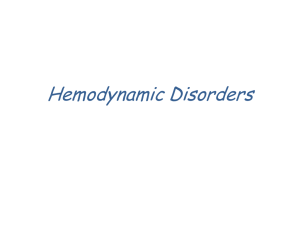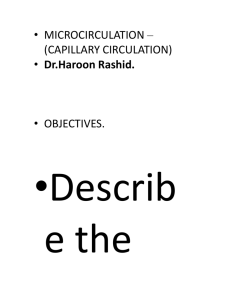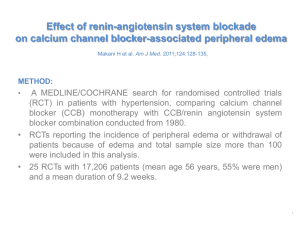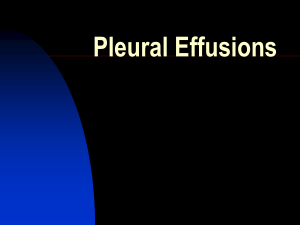Edema, Hyperemia and Congestion
advertisement
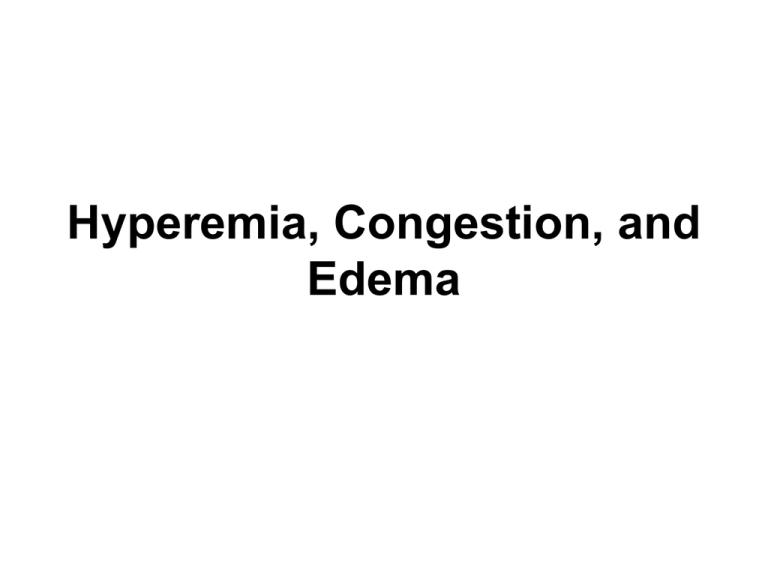
Hyperemia, Congestion, and Edema Hyperemia • Acute, actively increased blood flow • Tissues look red (erythema) Congestion • Chronic, passively reduced outflow • Tissues look pale or blue (cyanosis) Edema • Water build-up in interstitial spaces and cavities • Hydrodynamic transudate is dilute, protein-poor • Inflammatory exudate is concentrated, protein rich http://peer.tamu.edu/curriculum_modules/organsystems/module_4/Images/circulation_heart.jpg http://cccmkc.edu.hk/~sbjbiology/CERT%20BIO/Obtaining%20essentials%20for%20life/Transport%20in%20humans/Blood%20and%20blood%20cells%20experime nt_image/oxygenated%20and%20deoxygenated%20blood_oxygen,%20carbon%20dioxide%20and%20carbon%20monoxide.jpg Hyperemia • Increased flow of blood into tissue • Local process of arteriole dilation greater than venule dilation • Appearance of blood flow is RED • Normal physiological examples: Exercise Blushing Erection Inflammatory response (rubor) http://2.bp.blogspot.com/rdBezbztfrM/TWOQ8us2sVI/AAAAAAAACs0/_Q1kbP0ZRo4/s16 00/hyperemia.png http://upload.wikimedia.org/wikipedia/commons/thumb/5/58/Hyperemia_conjunctiva.jpg/1024px-Hyperemia_conjunctiva.jpg Hyperemia, injury Congestion • Impaired venous outflow from tissue • Local increases in venous pressure • Central congestive heart disease increases diastolic (venous) b.p. • Right-side failure congests portal drainage, liver, generalized edema • Left-side failure congests pulmonary drainage, lungs, hypoxemia http://2.bp.blogspot.com/-IWprL1YOgv8/TWOQO9ztteI/AAAAAAAACsk/uU6oSAAgZ5g/s1600/congestion.png http://radiographics.rsna.org/content/27/3/867/F24.large.jpg http://www.microscopy-uk.org.uk/mag/imgsep08/Apocap4.jpg Nutmeg liver Hepatic congestion Edema • Localized or generalized accumulation of fluid in interstitial spaces Anasarca: severe, generalized edema • ana = throughout, sark = flesh • Most commonly used to describe fetal or neonatal wholebody, subcutaneous swelling • Effusions into body cavities Hydrothorax: within thorax, around lungs; also pleural effusion Hydropericardium: Fluid in the pericardial sac Hydroperitoneum or ascites: Fluid in the peritoneal cavity • Extravasate: (v.) to move out of the vasculature Fluids—water intravascular interstitial intracellular total water 0 20 40 60 80 Percentage lean body mass 100 Approximately 60% of lean body weight is water. Two thirds of the body's water is intracellular, and the remainder is in extracellular compartments, mostly the interstitium (or third space) that lies between cells; only about 5% of total body water is in blood plasma. Factors affecting intravascular and interstitial water movement • Concentration of solutes Albumin and other proteins (huge difference) Sodium and other ions (small difference) • Hydrostatic pressure Higher on arteriolar side Lower on venular side Lowest in interstitium • Blood volume decreased b.p. Water intake/deprivation Water loss from skin or gut • Perspiration, vomiting, diarrhea Blood loss; acute hemorrhage Fluid transit The movement of water and low molecular weight solutes such as salts between the intravascular and interstitial spaces is controlled primarily by the opposing effect of vascular hydrostatic pressure and plasma colloid osmotic pressure. http://faculty.pasadena.edu/dkwon/chapter%2015/chapter%2015_files/images/image10.png If the movement of water into tissues (or body cavities) exceeds lymphatic drainage, fluid accumulates. An abnormal increase in interstitial fluid within tissues is called edema. Pitting edema Trivial and life-threatening edema Anasarca Appearance of edema • Swollen tissues (not cells—fluid is outside the cells) • Heavy tissues • Wet tissues • Widening of fascial planes or interlobular septa • Filled cavities Pulmonary edema Responses to edema • Skin: swells according to elasticity dependent edema: distribution affected by gravity (ankles, sacrum) dependent = hanging down in this context • Brain: compresses without room to swell • Lung: alveoli fill preventing gas exchange Causes of edema • Increased hydrostatic pressure Focal impairment—deep vein thrombosis Generalized impairment—right heart failure • Decreased plasma osmotic pressure Hypoproteinemia • Decreased protein synthesis—serum albumin • Increased protein loss to nephrotic syndrome • Sodium (and water) retention • Increased capillary permeability • inflammation or injury (burns) • Lymphatic obstruction • Filariasis, breast carcinoma TABLE 4-1 -- Pathophysiologic Categories of Edema INCREASED HYDROSTATIC PRESSURE Impaired venous return Congestive heart failure Constrictive pericarditis Ascites (liver cirrhosis) Venous obstruction or compression Thrombosis External pressure (e.g., mass) Lower extremity inactivity with prolonged dependency Arteriolar dilation Heat Neurohumoral dysregulation Modified from Leaf A, Cotran RS: Renal Pathophysiology, 3rd ed. New York, Oxford University Press, 1985, p 146. TABLE 4-1 -- Pathophysiologic Categories of Edema (con) REDUCED PLASMA OSMOTIC PRESSURE (HYPOPROTEINEMIA) Protein-losing glomerulopathies (nephrotic syndrome) Liver cirrhosis (ascites) Malnutrition Protein-losing gastroenteropathy LYMPHATIC OBSTRUCTION Inflammatory Neoplastic Postsurgical Postirradiation SODIUM RETENTION Excessive salt intake with renal insufficiency Increased tubular reabsorption of sodium Renal hypoperfusion Increased renin-angiotensin-aldosterone secretion Modified from Leaf A, Cotran RS: Renal Pathophysiology, 3rd ed. New York, Oxford University Press, 1985, p 146. Elephantiasis--lymphedema Peau d’orange and post-mastectomy lymphedema TABLE 4-1 -- Pathophysiologic Categories of Edema (con) INFLAMMATION Acute inflammation Chronic inflammation Angiogenesis Modified from Leaf A, Cotran RS: Renal Pathophysiology, 3rd ed. New York, Oxford University Press, 1985, p 146. Ascites is the accumulation of excess fluid within the peritoneal cavity. It is most frequently encountered in patients with cirrhosis and other forms of severe liver disease Ascites due to portal congestion Ascites The accumulation of ascitic fluid represents a state of totalbody sodium and water excess, but the event that initiates this imbalance is unclear. Effusions • Extravascular fluid collections can be classified as follows: Exudate: extravascular fluid collection that is rich in protein and/or cells. Fluid appears grossly cloudy. Transudate: extravascular fluid collection that is basically an ultrafiltrate of plasma with little protein and few or no cells. Fluid appears grossly clear. • Effusions into body cavities can be further described as follows: Serous: a transudate with mainly edema fluid and few cells. Serosanguinous: an effusion with red blood cells. Fibrinous (serofibrinous): fibrin strands are derived from a protein-rich exudate. Purulent: numerous PMN's are present. Also called "empyema" in the pleural space. Pleural effusions and edema Fibrinous exudate Pleural effusion Pleural effusion Dilated lymphatic vessels
